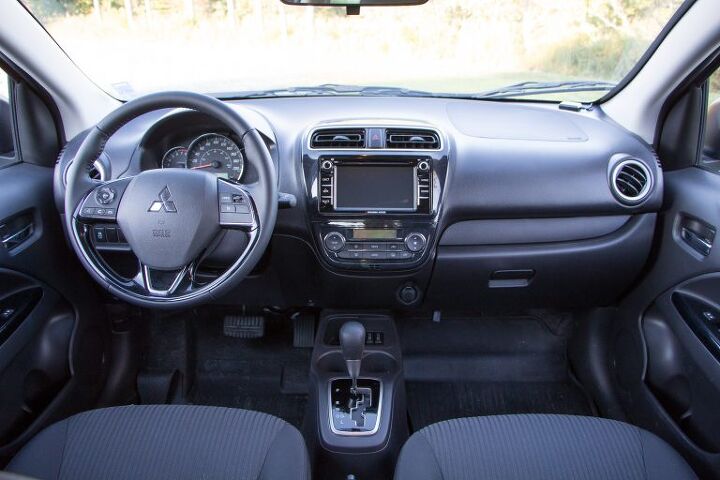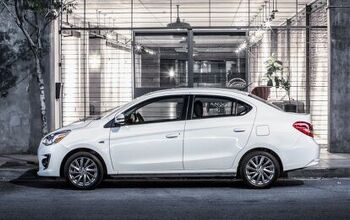2017 Mitsubishi Mirage G4 Review - It's Fine
I’m sitting on the pit lane of my local track — Atlantic Motorsports Park in Shubenacadie, Nova Scotia — surveying the empty course. My helmet is on the seat beside me, my hands are gripping the leather-wrapped wheel, and I can hear the low growl of three-cylinders idling as they wait for me.
But before I get to that, a bit about what I’m driving.
This is the Mitsubishi Mirage G4. It’s what happens when the oft-cheapest new hatchback in Canada (depending on who is offering what cash on the hood that month) grows a trunk. Under the hood: a 1.2-liter three-cylinder engine that has 78 horses in there somewhere. Connected to that is a continuously variable transmission, the only transmission available on this SEL trim tester.
I do a quick check of the course to make sure it’s still empty. My foot hits the floor.
The car isn’t quick to accelerate, but it’s not slow either. My daily is a Civic Hybrid and this Mirage definitely feels quicker than that. 2017 brings an extra four horses to the engine, which doesn’t sound like much, but it’s 5-percent more than before. The revs climb slowly, the speedo climbs more slowly, and I think back to what I said to the Mitsubishi guy when he approved this as I near the first turn.
“Don’t worry, I’m not planning any hot laps,” I said. I can already tell it won’t be a problem keeping my speed in check.
I approach the first turn with caution. The steering is quick to react, so I ease it into the corner. At the same rate I till the wheel, the car lists to port. I’m listening to see if the mud flaps or the mirrors scrape first. Neither happens.
Turn two is a hairpin left with bumpy concrete on the inside that starts downhill and changes sharply to an uphill climb just before the apex. The G4 handles the transition a lot better than I expected, but it does make very clear one of the biggest issues with the Mirage’s revised interior. They say they’ve upgraded some of the materials, but the seats are board flat and there is no armrest. I’m struggling to keep in my seat at a speed I would see in a grocery store parking lot.
I’m in for a long bout of acceleration through turn three and into four. The CVT responds well. While it’s still a CVT, it’s as good as the one in the Civic Touring I had last month. Most of the time. At times, the transmission is caught off guard — and then it can be clunky. There’s also a slight whine at lower revs. Strangely, it won’t let the engine rev above 5,500 rpm — which is confusing, because peak power is at 6,000 rpm.
Turn four is downhill and bumpy, and this showcases what is my biggest issue with the G4. If you’re in town or on the highway, it delivers a surprisingly well-sorted ride. Potholes and speed bumps are soaked up with aplomb; definitely better than Canada’s second-cheapest sedan, the Hyundai Accent. But on a rural road with some twists, every wheel seems to react completely differently when you add imperfect pavement to the mix. You can feel each corner dealing with the valleys and rises. You can feel the car moving laterally about its wheels. It’s not the tires; they’re too low profile to squirm that much, and I checked the air pressures myself. There’s something in the suspension tuning that is causing or allowing it. It’s very unsettling on the road.
I’m going down the backstretch, and the extra four inches of wheelbase in the sedan provides more stability in a straight line than the hatch. That same wheelbase gives it enough back seat room for 6’3” me to sit behind myself. But after that last turn, I’m wisely backing off and just going for a Sunday drive. Any hard cornering means I either fall out of the seat on the right or bang my head on the door frame on the left. The headliner feels cheap against my skull, but the door is reassuringly solid. I pull into the pit lane and get out of the car. I have a grin on my face, but I don’t want to do it again.
That last statement largely sums up the Mirage G4.
The 2017 Mirage hatch and G4 both have a new interior, and it’s ok. Sure, the dash is constructed of rock-hard plastic, but it looks fine. It’s a little slow, but it keeps up with traffic fine. The car only weighs 2,200 pounds, so it does well in cut and thrust urban driving. Its turning circle is tiny, the car feels narrow, and visibility is excellent, so you can stick it pretty much anywhere. Its interior provides plenty of room, you sit up high, and the trunk is acceptable.
But as soon as you turn in the Mirage G4, you fall out of the seat. If you hit a bump in that turn, you start to question Mitsubishi’s definition of “independent suspension.”
I know it’s popular to bash small and cheap cars, and I’ll admit I was planning a comparison of sorts with a Nova LFS transit bus, but I actually enjoyed this car — as long as I never went above the speed on the yellow sign on the off-ramp.
It has Bluetooth, a backup camera, and a touchscreen with Android Auto and Apple Carplay. I averaged just shy of 40 mpg. Nothing else for under $20,000 (Canadian) has all those things with a trunk. Air conditioning is vintage General Motors cold, and — what’s this? — there are even heated seats!
The plastics are hard, and you can see the cost cutting if you look for it (like the old-school metal door locks). Under the hood isn’t painted (just primed/plated), but there’s actually something here. Something … not fun, but it’s not a penalty either. It’s more comfortable than a Yaris, feels bigger inside than an Accent, and the build quality seems competitive for the “how cheap can we make this?” class.
I’ve driven the pre-refresh hatch. I despised it. This is definitely better. Not massively better, but better nonetheless. It’s fine. Which I seem to say a lot about this car. It sums it up well.
If you’ve ever thought about buying a Fiesta ST (or anything with a sporty suspension), this is obviously not the car you want. But if you’re like my little brother, who just wants to drive on the highway and downtown with a lot of space, in relative quiet, with a warranty that’ll outlast your finance term, and you want to spend as little money as possible, this is probably worth a drive.
My loaded SEL tester is selling for just over $17,000 (sticker is $18,498, but there are incentives), and that’s hard to ignore. Sure, there are cheaper and better used cars, but that’s apples to oranges.
Just don’t ever take the Mirage G4 anywhere near a track, unless you’re there to spectate.
[Image: © 2016 Evan Williams/The Truth About Cars]
More by Evan Williams
Latest Car Reviews
Read moreLatest Product Reviews
Read moreRecent Comments
- EBFlex Interesting. We are told there is insatiable demand for EVs yet here is another major manufacturer pivoting away from EV manufacturing and going to hybrid. Did these manufacturers finally realize that the government lied to them and that consumers really don’t want EVs?
- Kwik_Shift_Pro4X What's worse than a Malibu?
- MaintenanceCosts The current Malibu is poorly packaged; there's far more room inside a Camry or Accord, even though the exterior footprint is similar. It doesn't have any standout attributes to balance out the poor packaging. I won't miss it. But it is regrettable that none of our US-based carmakers will be selling an ordinary sedan in their home market.
- Jkross22 You can tell these companies are phoning these big sedans in. Tech isn't luxury. Hard to figure out isn't luxury.This looks terrible, there are a lot of screens, there's a lot to get used to and it's not that powerful. BMW gave up on this car along time ago. The nesting doll approach used to work when all of their cars were phenomenal. It doesn't work when there's nothing to aspire to with this brand, which is where they are today. Just had seen an A8 - prior generation before the current. What a sharp looking car. I didn't like how they drove, but they were beautifully designed. The current LS is a dog. The new A8 is ok, but the interior is a disaster, the Mercedes is peak gaudy and arguably Genesis gets closest to what these all should be, although it's no looker either.
- Ajla My only experience with this final version of the Malibu was a lady in her 70s literally crying to me about having one as a loaner while her Equinox got its engine replaced under warranty. The problem was that she could not comfortably get in and out of it.






































Comments
Join the conversation
This little blighter's as close as you can get to the masochism of the diesel Chevette.
Just get a used Civic.